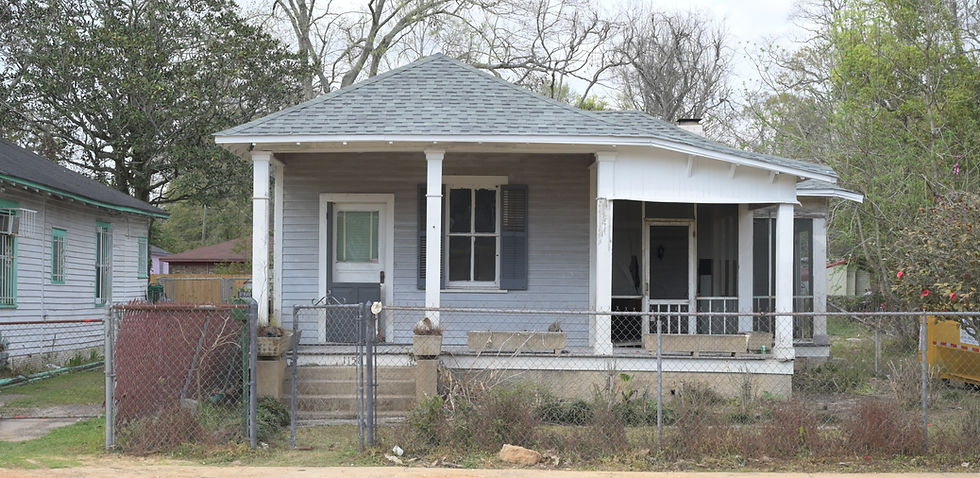Antique Bottles Excavated
- Restore Mobile
- Aug 3, 2021
- 3 min read

History comes alive on all of our project sites, but sometimes we get a little lagniappe in the process. Take a look at these antique bottles found by Jeff Semmes, who
requested permission to do an unofficial archaeological dig at one of our project properties in Oakdale. The bottles number twelve in total (one is missing from the above photograph) with six featuring embossed branding. Multiple companies are represented including "Dr. J Hostetter's Stomach Bitters," "Dr. Kilmer's Swamp Root Kidney Liver and Bladder Cure," and even a Mobile original, "E. Carre Company." We're not certain of the exact age of the bottles, it is likely they date from the mid-19th century through the early 20th century. These historical surprises give a glimpse into the world of the people that lived in these neighborhoods long ago and remind us that preservation can reconnect us to our own history while giving us clues to the past.
Here is a bit of information on three of the antique bottles discovered:
E. Carre Company – Mobile, ALA
In an article published by Mobile Bay Magazine, local historian Thomas McGehee writes "Fosko was a soft drink that was produced in Mobile at the E. Carre Bottling Company, which stood on the east side of Franklin Street, just north of Dauphin. Ed Carre was a French chemist who had established a soda water company here at the end of the Civil War and advertised mineral water, cider and soda water. After the introduction of flavored sodas at the 1876 World’s Fair in Philadelphia, Carre followed suit."
Carre’s business partner, J. Carleton Wilkins Sr., opened a candy store facing Dauphin Street, adjacent to the bottling company, called Wilkins-Higgins Candy Company. That building at 360 Dauphin, still stands today and is home to the restaurant Southern National on the ground floor and apartments above.
Read the full Mobile Bay Magazine McGehee here:

Dr. J Hostetter's Stomach Bitters
The antique collector website ShipWreckStore.com writes"During the second half of the 1800s, the Temperance Movement gained momentum. As states North and South enacted prohibition laws, Americans developed a strong thirst for bitters. Amid the early rumblings of this era, Dr. J. Hostetter’s Stomach Bitters emerged on the market in 1853, sold as a medicinal tonic. Its alcohol component was promoted as a vital ingredient, needed to “preserve the medicinal properties of vegetable extracts in a fluid state.”
Hostetter insisted that his secret formula gained its potency from its herbal ingredients – that the inclusion of whiskey, tipping the scales at a whopping 47 percent alcohol, was simply the best vehicle to deliver the remedy. “Just one bottle creates an appetite, forces off impure bile and purifies the system,” read an 1856 newspaper ad. But if one was good, two were better. “Two bottles cures bad livers and lends strength and cheerfulness."
Dr. Kilmer's Swamp Root Kidney Liver and Bladder Cure
The National Parks Service wrote this brief background on Dr. Kilmer's bottled concoctions:
"Dr. Sylvester Andral Kilmer was born in Cobleskill, New York in 1840. At eighteen he began studying homeopathic medicine under a renowned doctor in Schoharie County, New York. After years of medical instruction from all over the country, Dr. Kilmer returned to New York and set up a practice in Binghamton.
After settling in Binghamton, Kilmer set to work developing and selling homeopathic remedies. Over the years, he concocted many remedies in his Binghamton laboratory including Dr. Kilmer's Ocean Weed Heart Remedy, Female Remedy, Indian Cough and Consumption Cure, Autumn Leaf Extract, Prompt Parilla Pills, and his most well-known remedy: Dr. Kilmer’s Swamp Root Kidney Liver and Bladder Cure."
Fun Fact: The 1906 Pure Food and Drug Act banned the use of the word "cure" on bottles or in advertising in the U.S. unless the seller proved the claim in a clinical environment. This bottle features "cure" in the name which dates it before that protective legislation was enacted, meaning it very likely is at least 117 years old.



















Comments